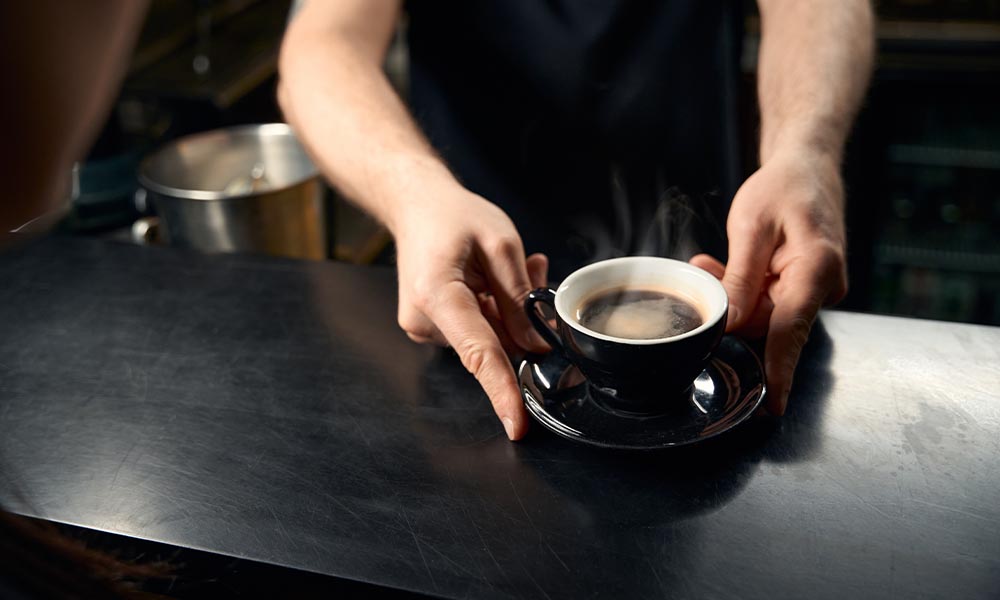

Americano coffee is one of the most iconic beverages in the global coffee scene, often associated with American culture. But how did this drink actually originate? What sets it apart from other coffee preparations? And why is it sometimes underrated in Italy? In this article, we’ll explore its history, curiosities, and the secrets to making the perfect Americano coffee.
The origins of americano coffee
The birth of Americano coffee dates back to the post-World War II era and is linked to the adaptation of Italian espresso to international tastes.
During and immediately after the Second World War, many American soldiers stationed in Italy found espresso too intense compared to their usual filtered coffee, which was milder and less concentrated. To suit their taste, they started diluting espresso with hot water, creating a drink more similar to their everyday coffee.
At that time, Italian cafés used lever espresso machines, which produced a rich and aromatic espresso. The addition of hot water made the coffee less intense while preserving its distinctive flavours. This adaptation led to a new variation, which was named “Americano” in honour of the American soldiers. It’s important not to confuse Americano coffee with filtered coffee, which is brewed through percolation without pressure and has a completely different flavour profile.

How to make an americano coffee
Making a quality Americano requires attention to detail, from selecting the best coffee blends to the preparation technique. Using a proper Americano coffee machine is crucial. Follow these steps to achieve a well-balanced and enjoyable drink.
Ingredients
- Properly extracted espresso
- Use 7-10g of ground coffee for a single shot (14-20g for a double).
- Extract it in 25-30 seconds to obtain 25-30ml of aromatic and creamy espresso.
- 100ml of hot water
- The ideal temperature is between 70-75°C to avoid burning the espresso or altering its flavour.
Method
- Extract the espresso
- The base is a high-quality espresso. Use freshly roasted coffee beans (within 2-3 weeks) and grind them just before brewing.
- Ensure the espresso machine is well-calibrated (9 bars of pressure, water temperature at 90-92°C).
- Heat the water
- Bring the water to the ideal temperature of 70-75°C.
- Use filtered or mineral water to avoid unwanted flavours.
- Combine espresso and water
- Classic method: Pour the hot water into the cup first, then slowly add the espresso to maintain its crema.
- Reverse method: Pour the hot water over the espresso for a more even mix and a smoother taste.
- Serve
- Use a cappuccino cup to ensure the right volume.
- Customise with sugar, milk, or a sprinkle of cocoa or cinnamon if desired.
Americano vs. filter coffee
Although they may seem similar, Americano coffee and filter coffee are two different beverages, both in preparation method and final taste.
Preparation
- Americano Coffee: Made by diluting an espresso with hot water. The pressure from the espresso machine (9 bars) maintains an intense aromatic structure.
- Filter Coffee: Brewed through percolation or immersion, without pressure, using methods such as Chemex, V60, or French Press. The result is a lighter drink with a complex and delicate aroma.
Flavour
- Americano Coffee: the taste depends largely on the quality of the espresso used. It offers more defined notes but can become unbalanced if the proportions are incorrect or if the coffee isn’t fresh.
- Filter Coffee: the slow extraction highlights floral, fruity, or spicy notes, making it sweet and delicate with minimal bitterness.
Consumption
- In the United States: filter coffee is a daily staple and is available everywhere, from large chains like Starbucks to specialty cafés that emphasise high-quality single-origin coffee.
- In Italy and Europe: Americano coffee is mainly preferred by tourists, while filter coffee is gaining popularity thanks to the specialty coffee movement.
Fun facts
In the United States, Americano coffee is less popular among locals than filter coffee, which is considered the go-to everyday brew. However, Americano is favoured by tourists as a middle ground between European espresso and traditional American coffee. In specialty coffee settings, filter coffee is often carefully prepared to showcase the quality of the beans.
How to make the best americano coffee at home
Making Americano coffee at home can be a rewarding experience if you follow some simple guidelines.
Essential tools
- Espresso machine: It must be well-calibrated to ensure optimal extraction.
- Scale: Essential for accurately measuring coffee and water.
- Temperature-controlled kettle: To heat the water to the ideal temperature.
- Filtered or mineral water: Water quality has a huge impact on the final taste.
Water temperature
Keep the water between 70-75°C. The correct temperature ensures that the water blends with the espresso without altering its aromatic profile.
Ideal roast
- Medium or light roast: Enhances the delicate aromatic notes of the coffee.
- Fresh coffee: Use beans that have been recently roasted and grind them just before brewing to preserve their full aroma.
Recommended blends and single origins
- Balanced blends: Ideal for those who prefer a smooth, traditional taste.
- Single origins: Beans from Ethiopia or Colombia are perfect for an aromatic and sophisticated Americano.
Americano coffee is far more than just “weak coffee.” It’s a versatile drink that embodies cultural adaptation, blending tradition with innovation. When prepared with care and quality ingredients, it can become a unique experience suited to every palate.
Try making it at home and share your experience with us on Caffelab!